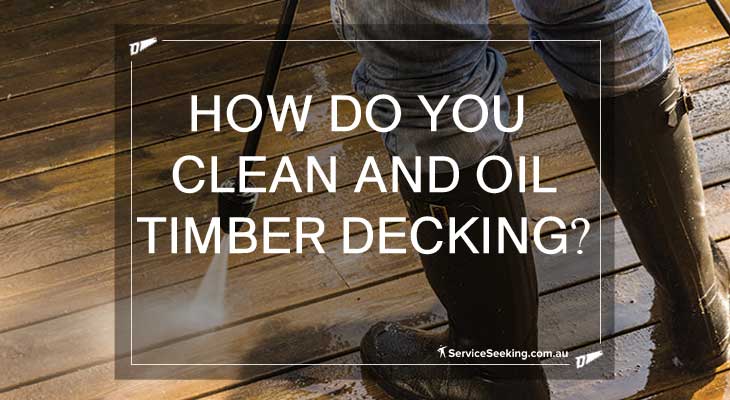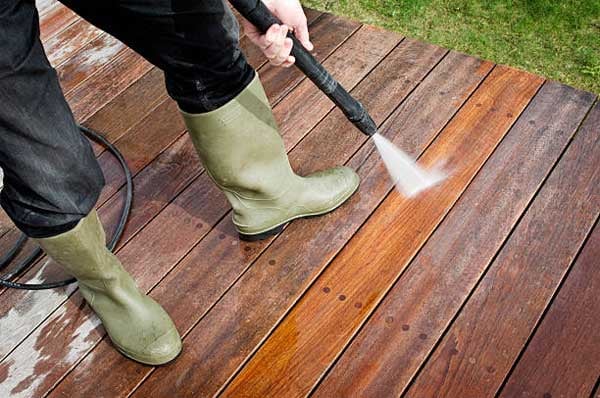How Do You Clean and Oil Timber Decking?
Step by step instructions about how to properly clean your timber decking. Learn how to stain it and oil it and what is the difference. Read more.

There is no treatment or preservative for the timber decking that is applied only once and then it lasts forever. Regardless of how you choose to clean and oil your timber decking, you have to be prepared that you will be doing it again and again, around once a year.
That is the only way to prolong the life of your timber decking and to make sure that it is properly protected from termites, borers, mildew, weather, fire and rot.
That is why a lot of people calculate these maintenance costs into the cost of their timber decking when purchasing it and making a decision whether to buy timber or composite decking.
It is important that you have decking experts on your side who can tell you what is the best choice for your conditions. Start by getting quotes from a real decking professional to install your timber decking and ask them about the maintenance of your deck.
How Do You Clean Timber Decking?
In time, you will see that your timber decking doesn’t look so fresh anymore. It grows pale, and some stains, dirt and dust are visible on it. Those are all sure signs that it is time for the proper deck cleaning. First, you need to make sure that you have all the necessary tools and cleaning agents, and then you can get to work.
- Check the weather prognosis – You need at least three sunny days to do your cleaning so that your decking properly dries.
- Get the tools and the cleaning agent ready – You will need a cleaning agent, a hard brush and a bucket of water if you don’t have a hose or a pressure washer. For the cleaning agent, you can choose one of the products that are made especially for timber decking cleaning, or you can use just any napisan-based cleaners.
- Apply the napisan or the cleaning agent – If you are opting for the Napisan cleaning, use a tub of Napisan in a bucket of hot water and dissolve it. Apply the solvent to the entire surface of your decking and let it sit for 15 minutes.
- Get scrubbing – Use a hard brush to thoroughly scrub away all the dirt and dust that piled up on your decking. Your decking needs to be wet when you scrub it, so if it dried out, splash it with a bit more water.
- Rinse – This is the moment when you should make sure that all the residue of your Napisan solution, together with the dirt and dust, is rinsed away. You can use a hose or buckets of fresh water. Once you do it, you need to leave your decking to dry for around two days. Make sure the water is not retained anywhere.
Can You Jet Wash Timber Decking?
Yes. This is a good alternative to the standard scrubbing of your deck, but you need to do it very carefully. Your power washer can clean all the little buildups of dust and dirt, but it can also damage your timber decking if you are not careful.
- Set your power washer to the appropriate strength. For softer wood, use 500 to 600 psi. For harder wood, go for 1 200 psi.
- Test the pressure washer on a stair or some secluded, easily replaced part of your decking.
- Start washing from your house outward. If possible, use sweeping motions along the lines of grain.
- Always keep your power washer at least 30 cm from the surface of your decking timber.

Image source: SAV’s Pressure Cleaning
If your timber decking is in great shape, this should be enough for its maintenance. But, if you doubt it, maybe it is time for oiling and coating. You can tell that by splashing the water on your decking surface. If the water stays on top of the decking timber, you are fine. If the decking timer soaks it up – you need to get to work.
How Do Your Oil Timber Decking?
If this is a new timber decking and it is made out of fresh timber, you need to wait until you boil it for the first time. It is not recommended to oil your new timber decking for at least two months. If you can wait three – even better. Some experts recommend six months. The freshly cut timber will release tannins and oils and that takes time. When it releases, then it is read for oiling.
Get the oil and test it on a small surface to get an idea about the drying time. Stir the oil thoroughly so that the pigments it contains spread out evenly. Soak the lambswool that you have attached to the long pole and evenly coat the boards one by one.
Read the instructions and check how much you need to wait before you apply the second coating. Keep in mind that you won’t need the same amount of oil for your second coating as you do for your first one, because the timber won’t be able to absorb it that much.
How Do You Stain Decking?
Besides oiling, you can add another layer of protection to your timber decking by staining it. There is a difference between oiling and staining, and it is mostly in the level of protection. While the oils get soaked up in the timber itself and protect it from within, staining offers better UV protection.
Before staining, you need to thoroughly wash the timber decking as described above. After that, you will need to gently sand over the decking surface. Only then can you stain your deck using the manufacturer’s instructions.
Whether to oil or stain your deck and how often to do it depends on your timber decking quality and the climate. Ask your decking installer about the maintenance of your decking, as they will definitely have some useful tips.
Get quotes from experienced local decking installers who can turn your projects into reality in the best possible way without you breaking the bank.
There are lots of local decking installers who can provide you with top-notch services. Take a look at ServiceSeeking.com.au’s highest-rated decking specialists in these major cities:
Sydney | Melbourne | Brisbane | Perth | Adelaide | Hobart | Canberra | Darwin